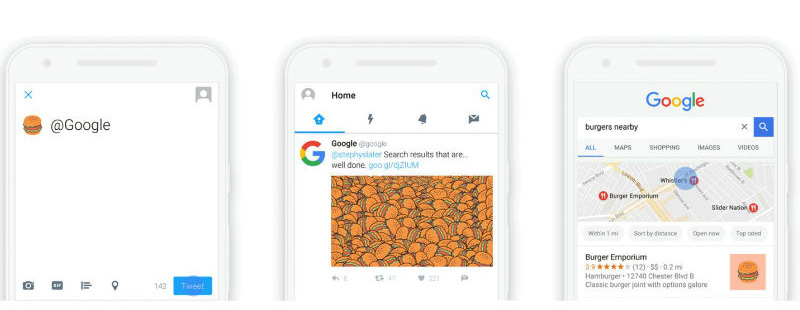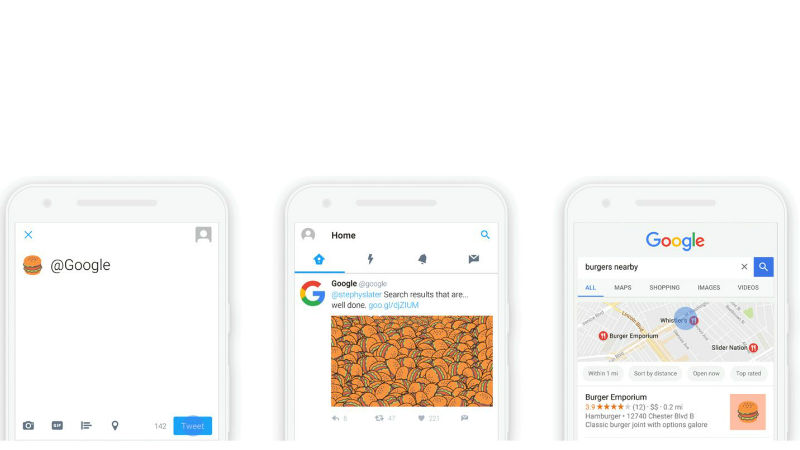
Domino’s pioneered the use of the pizza emoji as a sort of bat signal for pizza (you text one, and eventually pizza shows up). But Google just took things a step further, rolling out local search results in return for @Google emoji texts on Twitter. It’s a genius move, joining the dots between the brevity of mobile communication and the usefulness of location-based search info, in a way that’s fun and functional.
We speak emoji. Let’s talk. ? #KnowNearby pic.twitter.com/HjIMs3KPKe
— Google (@Google) December 6, 2016
A ranting bald Scotsman (OK, it was me) once declared of the smiley face emoticon, “I didn’t learn to read and write so I could communicate using a crude system of pictograms. If I did, I’d get a time machine and go back to ancient Egypt!” That was over a decade ago. Today, most of our communication channels are swimming in emojis.
Already an internet staple, emoticons got a massive boost when Apple added emoji support to the iPhone in 2011. Since then, people have pushed for emojis that reflect our racial diversity, with skin colors that go beyond standard Simpsons-yellow. Others have called Apple’s attempt at emoji inclusivity problematic, while one company made news advertising for an emoji translator to iron out cultural communication differences. There’s a World Emoji Day (July 17th, the date displayed on the iOS calendar emoji). There’s even an emoji movie in the works.
And they’re popping up all over the place in social media marketing. One study shows the majority of the 500 most followed brands on Twitter were using emojis by Q4 2015. Another shows that branded hashtags with emojis have driven comparatively more engagement than emoji-less for brands/events like Major League Baseball and the American Music Awards. If you want to pop on Twitter, branded hashtags are one way to go.
There’s an oft-cited statistic that people process visuals 60,000 faster than text, and visuals help people retain information. With emojis, we now have visually-enhanced communication tools to take advantage of that. With that said, they’re not the only visual communication game in town. Alex Chung, the CEO of Giphy has called GIFs the future of communication, packed as they are with pop culture references, emotions and concepts that “words can’t express”.
NASA, which excels at translating compelling visual assets into strong social media channels, recently landed on Giphy with “planets, astronauts, lots of high fiving (and) seriously cool images from the Mars Rover.” Meanwhile, in October, Giphy staged Loop Dreams, a one day art exhibit showcasing GIF artists. With their Giphycam app, you can blur the emoji/GIF divide, creating your own GIFs and covering them with all manner of digital stickers and emojis. Or just use the GIF keyboard in your favorite messenger app to use Nicholas Cage to get your point across for you.
From Facebook Messenger to Slack, GIFs and emojis are increasingly baked into the back-and-forth of everyday digital conversation. In fact, Google describes the latest version of Android as “(showcasing) more ways to express yourself” with more access to GIFs in Allo, Messenger and Hangouts apps.
From a brand perspective, don’t go all in on emojis and GIFs without thinking hard about their appropriateness to your brand voice. There’s the obvious danger of coming across like you’re trying too hard, Steve Buscemi style. But with branded chatbots becoming a thing, many automated customer conversations will lean on visual nuance to give their bots some personality. You don’t have to use them, but as mobile communication evolves, they deserve to be taken seriously.
As for the GIF- and emoji-fueled social signals that consumers are sending out? With machine learning, companies like Google, Facebook and Giphy will soon know a lot about the way you think, based on your go-to GIFs. Likewise, emojis and GIFs may soon become as critical to search marketing as keywords are today.
As much as myself-from-ten-years-ago railed against the rise of emoticons, clearly emojis have an ever-expanding place in marketing. Google-owned Nest’s new campaign, We ❤️ Home uses an emoji to market to home-owning dads. Which reminds me of the advertising ❤️ emoji that the world fell in love with when phones were still things that lived in booths, not back pockets.
The year? 1977. The slogan? I ❤️ New York, of course. When it comes to the communication power of symbols, the great ad man Milton Glaser was clearly ahead of his time. We’re all just catching up. Smiley face.
Looking to boost your search marketing powers, local or otherwise? Give Kiosk a call.
